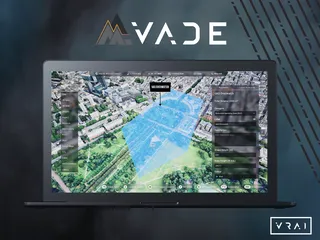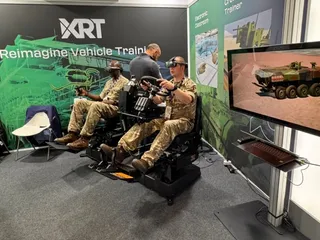More Training Capacity for Space Operators
Contact Our Team
For more information about how Halldale can add value to your marketing and promotional campaigns or to discuss event exhibitor and sponsorship opportunities, contact our team to find out more
The Americas -
holly.foster@halldale.com
Rest of World -
jeremy@halldale.com

Defense departments are raising the training readiness bar for their space commands. Individuals, units and staffs from these organizations are an ever-more visible and vital training audience in recent joint and combined exercises – and with good reason, as the events’ scenarios increasingly have a multi-domain operation construct, from the seabed to the frontiers of space, as most recently noted during Talisman Saber 2025.
At the same time, space commands and services are stepping up their investments in learning technologies for their training enterprises. One of several developments that caught the author’s attention was the recent announcement by PLEXSYS Interface Products (PLEXSYS) of its contract award by United States Space Command (USSPACECOM) to provide space warfighters with the PLEXSYS Ecosystem of products, including synthetic training, across the combatant command, and US partners and allies. This article provides a deep dive on some of the technologies PLEXSYS is supplying this vast and expanding learning audience and glimpses of how the S&T company is strengthening lifecycle support for the products by better allowing the customers to tailor the products for scenarios and gain other benefits.
Synthetic Training System
Ben Large, Space C2 Global Business Development Manager at PLEXYS, told the author his company is supporting USSPACECOM high-level training and concept development with three key components of the company’s Synthetic Training Ecosystem:
- Advanced Simulation Combat Operations Trainer (ASCOT) 7 is a high-fidelity environment generator designed for real-time, interactive, multi-platform simulation. ASCOT provides an immersive simulation background across single or multiple sites, with capability for a distributed, large-scale, modern, Live Virtual Constructive (LVC) world, including battlespace management across all domains. The modern, intuitive user interface simplifies the development of complex scenarios with dynamic entity creation, management, and comprehensive data link capabilities;
- ASCOT 7 is combined with the Sonomarc communications system, said to be “a powerful client/server, audio distribution and effects software package that provides training realism for fighter cockpits, civilian aviation, and ground-based communications with high-fidelity, low-latency performance.” The executive added this comprehensive communications system addresses live and virtual communication training needs across multiple platforms through the use of an instructor role-player, virtual people, record-and-replay capabilities, and scripted events; and
- the PLEXSYS Video Audio and Data for After-Action Review (VADAAR) tool, which records, monitors, and debriefs in the LVC environment – in essence, knitting together all key activities. Large explained the tool connects multiple participants into a coordinated brief or debrief for any live or training system, across multiple computer screens concurrently, with full video synchronization.
Large then explained how this contract elevates training for designated US and allied space operators – initially with ASCOT 7 enabling MDO training for warfighters. “It fuses the warfighting domains in a scalable manner, at the tactical, operational, and strategic levels. ASCOT can sit at the hub of a training solution, and at the spokes (operations centers and schoolhouses), enabling both localized and distributed/collective training,” he said and added, partner software for niche capabilities will also be fielded – ASCOT is designed and developed to sit as a key integrator for joint systems. “It’s simply a case of joining the dots; the software is already fielded as a multi-domain training solution for the US Navy, US Air Force and US Marine Corps, as well as globally, and is being leveraged by Australia, the UK, and NATO.”
Expanding Operators’ “How to” Capability
Beyond the ecosystem’s underpinning technologies is another insight deserving mention: the focus on allowing the customer to implement, use and modify the product.
Large reiterated that ASCOT 7 models all domains, from subsurface to space, with the ability to rapidly create accurate near-peer scenarios without requiring expertise in those domains. “This is a key differentiator that others do not possess to the same degree,” the executive said and noted for USSPACECOM, PLEXSYS optimized the features to focus primarily on training for Space Enabled Multi-Domain Operations, allowing the command to synchronize effects and integrate seamlessly with other warfighting domains.
And there is the Group Editor C2 Relationship Builder. ASCOT 7 allows users to rapidly create unique connections to entities in the scenario to replicate any type of network and tie these to other capabilities, such as Auto Fire and Decision Trees. Examples include the Integrated Air Defense System network with multiple layers from high-level C2 down to individual shooter, Beyond-the-Horizon targeting like Naval Cooperative Engagement capability, or Loyal Wingman with collaborative combat aircraft. Large noted, “Users can rapidly replicate tactical, theater, and global missile defense structures and their associated hierarchies, including sensors and shooters, in all domains.”
The community S&T expert also touched on data links – specifically Link-16. Large offered that the PLEXSYS Link-16 solution, stating in part, it is “unrivaled in terms of fidelity, realism, breadth of message sets represented, and overall network design. Anecdotal evidence – ASCOT 7 has regularly output synthetic blue and red Link-16 tracks into cockpits during exercises.”
Of no surprise PLEXSYS is another S&T company with a “best-of-breed” approach to partnering, as it integrates seamless data exchange, the use of common protocols (DIS or HLA) and other capabilities into its synthetic training solutions.
Eyes on Evolving and Projected Future Threats
PLEXSYS is significantly preparing ASCOT 7 for use in scenarios with current and evolving threat sets. To point, ASCOT 7 was said to allow a user to create advanced and emerging threats, including FOBS (fractional orbital bombardment system), MOBS (multiple orbit bombardment systems), HGV (hypersonic glide vehicle), Multi-Stage Ballistic Missiles from all platforms, advanced cruise missiles and drones, all with varying payloads, countermeasures, and warheads. “This is a unique feature that has direct and significant application to not only USSPACECOM's mission, but to Golden Dome for America. We have been able to build the holistic threat picture and potential Golden Dome solutions within the
synthetic environment, which is extremely powerful.” PLEXSYS is planning to demo a live training scenarios built on Golden Dome during I/ITSEC 2025.


